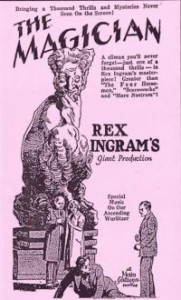The Birth of Oliver Haddo
Some of you may be familiar with the name “Oliver Haddo.” It’s the name Aleister Crowley used (he used lots of pseudonyms) when he wrote a few items.
The source of the name, however, is from a book entitled The Magician by Somerset Maugham, author of such books as Of Human Bondage, The Moon and Sixpence, and my personal favorite, The Razor’s Edge.
Maugham had met Crowley in Paris, and supposedly didn’t like him. Yet, he modeled the antagonist of his 1908 book The Magician, Oliver Haddo, after Crowley. According Richard Kaczynski, Crowley read the book and recognized himself as Haddo. He recognized things he, himself, had said…and a lot more. Crowley wrote a review of the book using the pen name Oliver Haddo. Published in the famed magazine “Vanity Fair,” it accused Maugham of extensive plagiarism, copying from books by Eliphas Levi, McGregor Mathers, and even from “The Island of Dr. Moreau” as well as from others. I guess that was another reason for Maugham to dislike Crowley.

Movie poster for The Magician (1926)
In 1926, Rex Ingram (a famous film director who made “The Four Horsemen of the Apocalypse” that made Rudolph Valentino a star) made a film version of “The Magician.” Starring in the role of Oliver Haddo was the German actor and director Paul Wegener (his only Hollywood role), now famous for his earlier movie, “The Golem.”
Last night, the Turner Classic Movie (TCM) channel, for the first time ever, showed Ingram’s film. Wegener was a large, barrel-chested man with odd, almond-shaped eyes. He was both repelling and alluring, qualities some people have attributed to Crowley. The plot has Crowley Haddo as a combination wizard, alchemist, and mad (literally) scientist attempting (for no stated reason) to create life. Unfortunately, this required the blood from the heart of a “maiden.” With this background, the plot becomes obvious. Happy woman is seduced away from her fiance by Haddo. Fiance searches for her, finds her during the final magickal rite, kills Haddo and saves his love.
According to Kaczynski, when the film was about to premier, Crowley tried to get an injunction to stop it. He claimed he should receive compensation as the model for Haddo. “Crowley’s plan was to block the film’s showing in order to get a contract to make a series of educational films about magick. When the studio’s representatives contacted him and offered a financial settlement, Crowley refused the offer.” Unfortunately, there was no movie deal, the premier was held on schedule, and Crowley got nothing.
Well, that’s the story of Crowley, Maugham, and Oliver Haddo. Currently, TCM shows a silent film each Sunday evening, so you might want to watch their schedule to see when it’s showing again. Although the movie was filmed in black an white, as was actually common of films in that period, the film was tinted in various places (blue, red, sepia) to help add to the emotions of the film. If you’re used to seeing old films in just black and white, this will give you an idea of what people seeing the original would have seen. Of course, it’s a silent film, but they’ve added a music score. The original music is fine, but at times they use rather obvious, overly well-known classical melodies and music to amplify a scene. I found this rather clichéd.
Kaczynski adds that James Whale, director of the original Frankenstein and Dracula films, viewed The Magician repeatedly, and there are several similarities in those films. Certain views of Haddo match the filming of certain shots of Bela Lugosi as Dracula. The tower where Haddo has his headquarters is almost the same as that in Frankenstein. Haddo’s assistant, like Dr. Frankenstein’s, is a hunchback. And finally, the destruction of the tower at the end of Whale’s Bride of Frankenstein looks almost identical to the destruction of Haddo’s tower headquarters.
I looked at the TCM website and didn’t see that this film was for sale, but since it had a new copyright added to it, I’m going to assume that it will become available to film buffs and Crowley fans.
Did you see it? What did you think of it?








Have no recall of seeing The Magician,yet, I love The Golem which may be seen on the internet,such as cinemanow.com, or veoh.com. If your a big fan of the Aleister-man a new film was recently released from the U.K titled “The Cathedral of Thelema”,its the fraters work and teachings and biography combined,parts are viewable at youtube.com,but I have not found it for sale as of yet for personal viewing.
[…] part of the Brighton Fringe Festival, come see the film Aleister Crowley tried to ban (well, sort of!) with an introduction by Gary Lachman, and a live soundtrack by the fabulous Ragged Ragtime Band, […]
[…] becomes his magickal lackey. More specifically, the Voldemort figure (the latest incarnation of Oliver Haddo — W. Somerset Maugham‘s piss-taking proxy for Aleister Crowley) at long last delivers his […]
[…] Maugham based the title character of his 1908 novel The Magician on Crowley. And Crowley was…flattered? […]